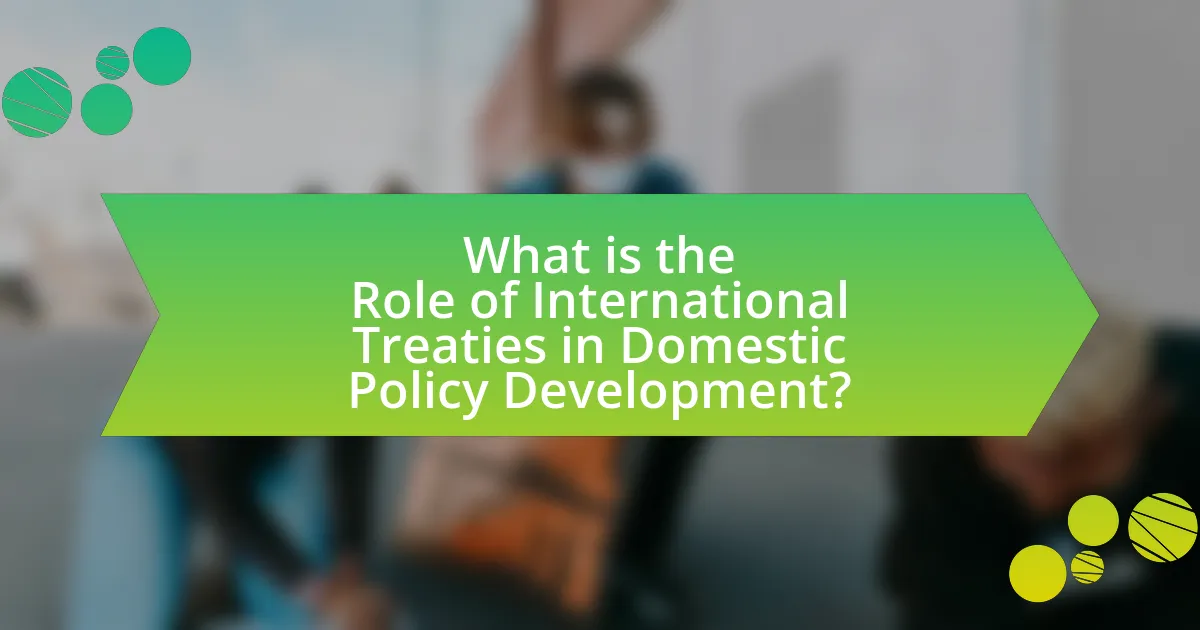International treaties are essential instruments that significantly influence domestic policy development by establishing binding commitments for countries. These treaties shape national legislation, requiring governments to align their laws with international standards in areas such as trade, human rights, and environmental protection. The article explores the mechanisms through which treaties affect domestic laws, the interaction between treaties and existing legal frameworks, and the challenges of integrating international agreements into national policies. It also highlights the role of various stakeholders, including civil society and political parties, in advocating for treaty compliance and the best practices that can enhance the effectiveness of treaties in shaping domestic governance.

What is the Role of International Treaties in Domestic Policy Development?
International treaties play a crucial role in shaping domestic policy development by establishing binding commitments that countries must adhere to. These treaties influence national legislation, as governments often align their laws and regulations with international standards to fulfill their treaty obligations. For instance, the Paris Agreement on climate change has prompted many nations to implement policies aimed at reducing greenhouse gas emissions, demonstrating how international agreements can drive domestic environmental policy. Furthermore, treaties can facilitate cooperation among countries, leading to shared approaches in areas such as trade, human rights, and security, thereby impacting domestic policy frameworks.
How do international treaties influence national legislation?
International treaties influence national legislation by establishing binding obligations that countries must incorporate into their domestic laws. When a nation ratifies a treaty, it commits to aligning its legal framework with the treaty’s provisions, which often necessitates changes in existing laws or the creation of new legislation. For example, the United Nations Convention on the Rights of the Child requires signatory countries to enact laws that protect children’s rights, leading many nations to reform their legal systems to comply with international standards. This process ensures that international norms are reflected in national policies, thereby shaping domestic legal practices and frameworks.
What are the mechanisms through which treaties affect domestic laws?
Treaties affect domestic laws primarily through incorporation, transformation, and direct applicability mechanisms. Incorporation occurs when a treaty is formally adopted into domestic law, requiring legislative action to align national statutes with treaty obligations. Transformation involves the modification of existing laws to comply with treaty requirements, ensuring that domestic legal frameworks reflect international commitments. Direct applicability allows certain treaties to have immediate legal effect within a country without the need for additional legislation, as seen in the European Union’s legal framework where EU treaties directly influence member states’ laws. These mechanisms ensure that international agreements are integrated into national legal systems, thereby shaping domestic policy and governance.
How do treaties interact with existing legal frameworks?
Treaties interact with existing legal frameworks by establishing binding obligations that can modify or complement domestic laws. When a state ratifies a treaty, it often requires changes to national legislation to ensure compliance with the treaty’s provisions, thereby integrating international norms into the domestic legal system. For example, the Vienna Convention on the Law of Treaties outlines that treaties must be performed in good faith, which can necessitate adjustments in national laws to align with international commitments. This interaction is further evidenced by the practice of many countries, such as the United States, where treaties can have direct legal effects or require implementing legislation to be enforceable domestically.
Why are international treaties important for domestic policy?
International treaties are important for domestic policy because they establish binding commitments that influence national laws and regulations. These treaties often address critical issues such as trade, human rights, and environmental protection, requiring countries to align their domestic policies with international standards. For example, the Paris Agreement on climate change compels signatory nations to implement policies aimed at reducing greenhouse gas emissions, thereby shaping their domestic environmental legislation. Additionally, treaties can facilitate cooperation between countries, leading to shared resources and strategies that enhance national security and economic stability.
What benefits do treaties provide to national governments?
Treaties provide national governments with several key benefits, including enhanced diplomatic relations, legal frameworks for cooperation, and mechanisms for conflict resolution. These agreements facilitate collaboration on issues such as trade, security, and environmental protection, which can lead to economic growth and stability. For instance, the North American Free Trade Agreement (NAFTA) significantly increased trade among the United States, Canada, and Mexico, demonstrating how treaties can boost economic interdependence and prosperity. Additionally, treaties often establish international norms and standards, which can help governments align their domestic policies with global expectations, thereby improving their international standing and credibility.
How do treaties promote international cooperation and compliance?
Treaties promote international cooperation and compliance by establishing legally binding agreements that create a framework for collaboration among nations. These agreements facilitate dialogue, set common standards, and outline specific obligations that countries must adhere to, thereby fostering trust and predictability in international relations. For instance, the Paris Agreement on climate change commits signatory countries to specific emissions reduction targets, encouraging collective action towards a common goal. This binding nature of treaties incentivizes compliance, as nations face diplomatic and economic repercussions for failing to meet their commitments, thus reinforcing the importance of adherence to international norms and cooperation.

What types of international treaties impact domestic policy?
International treaties that impact domestic policy include trade agreements, human rights treaties, environmental accords, and security pacts. Trade agreements, such as the North American Free Trade Agreement (NAFTA), influence domestic economic policies by regulating tariffs and trade practices. Human rights treaties, like the International Covenant on Civil and Political Rights, compel nations to align their laws with international human rights standards. Environmental accords, such as the Paris Agreement, require countries to implement policies aimed at reducing carbon emissions. Security pacts, such as NATO agreements, can shape defense policies and military spending. Each of these treaty types necessitates changes or adaptations in domestic legislation to comply with international obligations.
What are the different categories of international treaties?
International treaties are categorized into several types, primarily including bilateral treaties, multilateral treaties, and regional treaties. Bilateral treaties involve two parties, often countries, and govern specific agreements between them, such as trade or defense pacts. Multilateral treaties, on the other hand, involve three or more parties and address broader issues like environmental protection or human rights, exemplified by the Paris Agreement. Regional treaties focus on agreements within a specific geographic area, such as the North American Free Trade Agreement (NAFTA), which facilitates trade among member countries in North America. These categories reflect the scope and nature of international cooperation and legal obligations among states.
How do trade agreements shape domestic economic policies?
Trade agreements shape domestic economic policies by establishing rules and standards that countries must adhere to in order to facilitate international trade. These agreements often lead to changes in tariffs, regulations, and market access, which directly influence domestic industries and economic strategies. For example, the North American Free Trade Agreement (NAFTA) significantly altered trade dynamics between the U.S., Canada, and Mexico, prompting shifts in agricultural and manufacturing policies to enhance competitiveness in the global market. Consequently, domestic policies may be restructured to align with the commitments made in these agreements, affecting labor laws, environmental regulations, and economic incentives to attract foreign investment.
What role do human rights treaties play in domestic law?
Human rights treaties serve as binding legal instruments that influence domestic law by establishing standards for the protection of individual rights. These treaties require states to align their national legislation with international human rights norms, thereby promoting accountability and legal recourse for violations. For instance, the International Covenant on Civil and Political Rights mandates signatory countries to ensure the rights it enshrines are reflected in their domestic legal frameworks, which can lead to the enactment of laws that protect freedoms such as speech, assembly, and due process. Additionally, courts in many countries often reference these treaties when interpreting domestic laws, reinforcing their role in shaping legal outcomes and ensuring compliance with international obligations.
How do multilateral treaties differ from bilateral treaties in their impact?
Multilateral treaties have a broader impact than bilateral treaties due to their involvement of multiple countries, which facilitates collective action and establishes comprehensive frameworks for international cooperation. For instance, the Paris Agreement, a multilateral treaty, aims to combat climate change by requiring commitments from nearly 200 countries, thereby creating a unified approach to a global issue. In contrast, bilateral treaties, such as the U.S.-Mexico-Canada Agreement, primarily focus on the specific interests and negotiations between two nations, limiting their influence to those parties. This difference in scope means that multilateral treaties can lead to more significant changes in international norms and policies, as they often address issues that transcend national borders, such as environmental protection, human rights, and trade regulations.
What are the specific challenges of implementing multilateral treaties?
The specific challenges of implementing multilateral treaties include differing national interests, varying levels of commitment among signatories, and the complexity of domestic legal integration. Differing national interests can lead to conflicts in priorities, making consensus difficult. For example, the Paris Agreement on climate change faces challenges as countries prioritize economic growth over environmental commitments. Varying levels of commitment result in some nations adhering strictly to treaty obligations while others may not, undermining collective goals. Additionally, the complexity of integrating international treaties into domestic law can create legal hurdles, as seen in the implementation of the Convention on Biological Diversity, where countries struggle to align national legislation with international standards. These factors collectively hinder the effective implementation of multilateral treaties.
How do bilateral treaties facilitate quicker policy changes?
Bilateral treaties facilitate quicker policy changes by establishing direct agreements between two nations that streamline decision-making processes. These treaties often include specific provisions that allow for rapid implementation of agreed-upon policies, reducing the time typically required for legislative approval. For instance, the North American Free Trade Agreement (NAFTA) enabled the U.S., Canada, and Mexico to swiftly adjust trade policies in response to economic shifts, demonstrating how bilateral agreements can expedite policy adaptation.

What challenges arise from the integration of international treaties into domestic policy?
The integration of international treaties into domestic policy presents several challenges, including legal conflicts, compliance issues, and political resistance. Legal conflicts arise when domestic laws contradict treaty obligations, leading to uncertainty about which laws take precedence. Compliance issues occur as governments may struggle to implement treaty provisions effectively due to resource constraints or lack of expertise. Political resistance can stem from differing national interests or public opinion, which may hinder the ratification or enforcement of treaties. For instance, the U.S. has faced challenges in aligning its domestic laws with international agreements like the Paris Agreement on climate change, illustrating the complexities involved in such integrations.
What legal conflicts can occur between international treaties and domestic laws?
Legal conflicts between international treaties and domestic laws can arise when a country’s domestic legislation contradicts the obligations established by an international treaty. For instance, if a nation ratifies a treaty that mandates specific human rights protections, but its domestic laws allow practices that violate those rights, a conflict occurs. This situation can lead to legal dilemmas where courts must decide whether to prioritize the treaty obligations or uphold domestic laws. Historical examples include the U.S. Supreme Court case of Medellín v. Texas, where the court ruled that international treaties do not automatically have domestic legal effect unless implemented by Congress, highlighting the potential for conflict between international commitments and national law.
How do courts resolve conflicts between treaties and national legislation?
Courts resolve conflicts between treaties and national legislation by applying the principle of supremacy of international law or the doctrine of incorporation, depending on the jurisdiction. In many countries, if a treaty is ratified and becomes part of domestic law, it may take precedence over conflicting national legislation. For example, in the United States, the Supremacy Clause of the Constitution establishes that treaties made under its authority are the supreme law of the land, meaning they can override state laws and conflicting federal statutes. Conversely, in jurisdictions where national legislation is prioritized, courts may interpret treaties in a manner that aligns with existing laws, thereby maintaining legislative supremacy. This approach ensures that the legal framework remains coherent while respecting international obligations.
What role do constitutional provisions play in treaty implementation?
Constitutional provisions play a critical role in treaty implementation by establishing the legal framework within which treaties are integrated into domestic law. These provisions dictate the processes and requirements for ratifying treaties, often requiring legislative approval or specific procedures to ensure compliance with national legal standards. For example, in the United States, Article II, Section 2 of the Constitution mandates that treaties must be ratified by a two-thirds majority in the Senate, thereby ensuring that international agreements align with the country’s legal and political framework. This constitutional requirement ensures that treaties are not only recognized but also effectively enforced within the domestic legal system, thereby influencing domestic policy development and implementation.
How can domestic stakeholders influence treaty implementation?
Domestic stakeholders can influence treaty implementation by actively engaging in the legislative process, advocating for specific policies, and holding government accountable. For instance, civil society organizations often mobilize public opinion and lobby lawmakers to ensure that treaty obligations are reflected in national laws. Additionally, businesses may leverage their economic power to push for favorable regulatory frameworks that align with international commitments. Research shows that stakeholder engagement can significantly enhance compliance rates, as seen in the implementation of the Paris Agreement, where local governments and NGOs played crucial roles in promoting climate action initiatives.
What strategies can civil society organizations use to advocate for treaty compliance?
Civil society organizations can advocate for treaty compliance through strategies such as public awareness campaigns, legal advocacy, and coalition building. Public awareness campaigns educate the public and policymakers about the importance of treaty obligations, thereby increasing pressure for compliance. Legal advocacy involves utilizing national and international legal frameworks to hold governments accountable for their treaty commitments, as seen in cases where NGOs have successfully challenged non-compliance in court. Coalition building allows organizations to unite diverse stakeholders, amplifying their voice and influence, which has proven effective in various contexts, such as the coalition efforts seen in the campaign for the Convention on the Rights of Persons with Disabilities. These strategies collectively enhance the effectiveness of civil society organizations in promoting adherence to international treaties.
How do political parties shape the domestic response to international treaties?
Political parties significantly shape the domestic response to international treaties by influencing public opinion, legislative processes, and executive actions. For instance, parties often align their platforms with specific treaties, mobilizing their base to support or oppose them, which can sway public sentiment and impact the political discourse surrounding the treaty. Additionally, parties in power can dictate the legislative agenda, determining whether a treaty is ratified or implemented through domestic law. Historical examples include the U.S. Senate’s ratification of the North American Free Trade Agreement (NAFTA) in 1993, where the Democratic and Republican parties had differing views that influenced the treaty’s acceptance. This dynamic illustrates how party ideology and strategy directly affect the domestic response to international agreements.
What best practices can enhance the effectiveness of treaties in domestic policy development?
Best practices that enhance the effectiveness of treaties in domestic policy development include ensuring stakeholder engagement, aligning treaty provisions with national priorities, and establishing clear implementation mechanisms. Stakeholder engagement, such as involving civil society and local communities, fosters broader support and compliance, as evidenced by the successful implementation of the Paris Agreement, which involved extensive consultations with various stakeholders. Aligning treaty provisions with national priorities ensures that treaties are relevant and actionable within the domestic context, as seen in the integration of the Convention on Biological Diversity into national biodiversity strategies. Establishing clear implementation mechanisms, including designated authorities and timelines, facilitates accountability and progress tracking, which is crucial for the successful domestication of treaties, as demonstrated by the effective implementation of the United Nations Convention Against Corruption in various countries.






